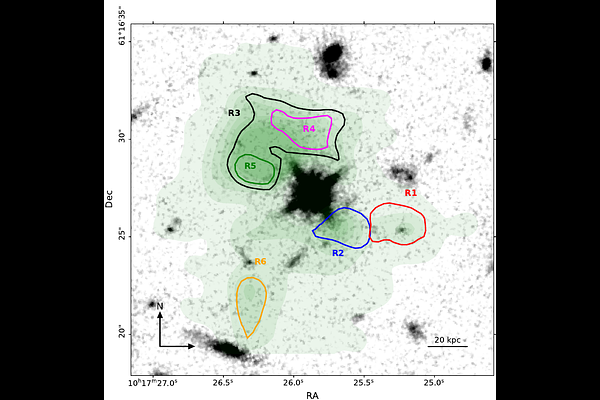Coevolution of halo and quasar properties in dense environments: CARLA J1017+6116 at z=2.8

Coevolution of halo and quasar properties in dense environments: CARLA J1017+6116 at z=2.8
Sofia G. Gallego, Simona Mei, Christopher Martin, Donal O'Sullivan, Emanuele Daddi, Dominika Wylezalek, Nicholas Seymour
AbstractRadio-loud active galactic nuclei, in particular radio-loud quasars, are fueled by accretion onto supermassive black holes and are among the most energetic sources in the Universe. While their impact on their surroundings - from the interstellar medium to the circumgalactic medium - is well recognized, the specific mechanisms remain uncertain. In this study we analyze deep Keck Cosmic Web Imager observations of the Lyman-alpha (Lya) halo surrounding the radio-loud quasar at the center of the cluster CARLA J1017+6116 at redshift z = 2.8. As is known from previous observations, the cluster hosts a high fraction of early-type galaxies, and the star formation of its spectroscopically confirmed cluster members is typical of or higher than that of galaxies on the main sequence. We find that the Lya halo extends at least 16 arcsec (128 pkpc) down to a surface brightness level of 1e-19 erg/s/cm^2/arcsec^2, with a total observed Lya luminosity of log10(L/Lsun) = 43.35 +- 0.05. The halo has distinct kinematic regions with asymmetries suggestive of complex interactions between the quasar and the intracluster medium, possibly driven by a combination of biconical feedback and episodic activity. Despite the quasar classification, our reanalysis of very long baseline interferometry data finds no evidence of extended jet structures; we instead find compact and variable radio emission that could indicate episodic jet activity or suppression by the dense interstellar medium. Combining these observations with imaging obtained with the Hubble Space Telescope, we identified one Lya-emitting source within the quasar halo. While mechanical feedback from a jet appears limited or episodic, radiative feedback likely plays a dominant role in shaping the extended Lya halo, highlighting the complex interplay between quasar-driven processes and the surrounding dense environment.